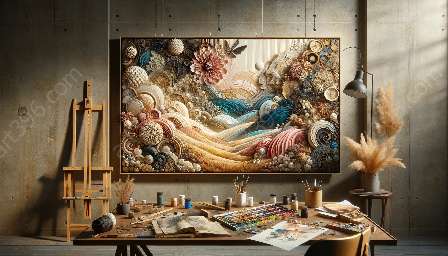Mixed media art is a versatile and innovative form of artistic expression that combines various materials, techniques, and ideas to create multidimensional and visually stimulating artwork. It has the power to bridge the gap between traditional and modern artistic practices by merging historical artistic elements with contemporary approaches, thereby offering a glimpse into the evolving nature of art and culture.
Historical Context of Mixed Media Art
Mixed media art has historical roots that date back centuries, with artists incorporating diverse materials into their works long before the term 'mixed media' became prevalent. Early examples can be found in ancient cave paintings, where artists combined natural pigments with charcoal or clay to create striking imagery. The use of gold leaf in religious paintings during the Renaissance is another historical example of mixed media art, showcasing how various materials were integrated to enhance visual impact.
Throughout art history, artists have continuously experimented with different mediums and techniques, blurring the lines between traditional disciplines and paving the way for the evolution of mixed media art. The fusion of painting, sculpture, collage, and assemblage exemplifies the diverse and adaptable nature of mixed media, showcasing how it seamlessly integrates elements from various artistic traditions into a unified form.
Modern Interpretations and Techniques
In the modern era, mixed media art has flourished as artists push the boundaries of traditional artistic practices by embracing unconventional materials and methods. This includes the incorporation of digital technologies, found objects, recycled materials, and unconventional surfaces to create thought-provoking compositions and installations. These innovative approaches demonstrate how mixed media art transcends conventional artistic boundaries, serving as a platform for experimentation and exploration.
Furthermore, the interdisciplinary nature of mixed media art allows artists to engage with themes and concepts that reflect the complexities of contemporary culture and society. By integrating diverse materials and visual elements, artists can communicate layered narratives and explore multifaceted perspectives, offering audiences an immersive and immersive artistic experience.
Cultural Significance and Impact
Mixed media art plays a pivotal role in bridging cultural divides and fostering inclusivity by embracing diverse perspectives and experiences. Through the fusion of traditional and modern elements, artists are able to celebrate cultural diversity, challenge societal norms, and address pressing issues, thereby contributing to a more inclusive and reflective artistic landscape. This inclusive approach also provides a platform for underrepresented voices and marginalized communities to share their stories and enrich the collective tapestry of art and culture.
Moreover, the accessibility and adaptability of mixed media art make it a powerful tool for cultural expression and engagement. Artists can draw from a wide range of influences, traditions, and techniques, enabling them to create artworks that resonate with diverse audiences and transcend cultural boundaries. This versatility aligns with the ever-evolving nature of contemporary culture, reflecting the intersectionality and interconnectedness of global artistic practices.
Conclusion
Mixed media art serves as a dynamic bridge that connects the rich heritage of traditional artistic practices with the dynamic innovations of modern art, offering a compelling fusion of historical depth and contemporary relevance. Its ability to amalgamate diverse materials, techniques, and ideas exemplifies the transformative power of artistic expression, shaping the cultural landscape and fostering meaningful dialogues. As mixed media art continues to evolve, it will undoubtedly remain a testament to the enduring connection between tradition and modernity within the realm of art and culture.

